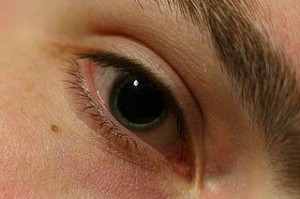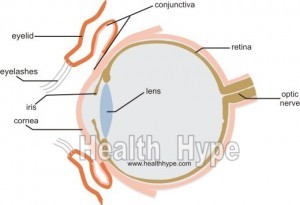what does it mean when someone eye pupils turn from brown to black ?
The pupils are the dark centers of the eye where lite tin can enter the inner eyeball. The size of the pupil's change with varying light weather to allow more or less light into the eyeball. This is controlled by the iris. When the educatee's are enlarged it is dilated and when it is small information technology is constricted. While these changes are not abnormal with different light conditions, sometimes the pupils are abnormally enlarged.
What are dilated pupils?
Dilated pupils are where the black center part of the eye is abnormally enlarged. This is known as mydriasis. While it is not abnormal for the pupils to be enlarged in night conditions, information technology should ordinarily respond to light and constrict accordingly. When it fails to answer to low-cal and are enlarged, and then the pupils are said to be dilated. Ordinarily both pupils tuck or dilate at the aforementioned time simply in some cases, simply one student changes in size. This is seen in anisocoria.
There are a number of different causes of dilated pupils. It may exist a symptom of certain diseases and disorders, as well as occur with the use of certain medication, illicit substances and toxins.. Pupils that are dilated and unresponsive to light are one of the signs of death, as the office of the brain that regulates the size of the pupil shuts downwards. However, this too depends on other signs such as an absent pulse, inactivity of the heart and abeyance of animate. Therefore dilated pupils on its own may not be a sign of death.

Causes of Dilated Pupils
The brain can control the contraction and relaxation of the muscles of the iris which in plough changes the pupil size. Dilatation of the pupils are controlled by the sympathetic nervous organisation which is part of the autonomic system. This means that actions like dilatation of the pupils is involuntary.
Physiologic dilatation occurs with reduced lite intensity, stiff emotions and when the 'fight or flying' response is initiated. This is non considered to exist abnormal. Pathologic causes is where student dilation is due to some diseases. Iatrogenic causes is where the pupils get dilated due to the action of sure medication.

Parts of the Human being Eye
Medication
Sometimes drugs are administered for the purposes of dilating the pupils in order to examine the inner middle. These drugs are known as mydriatic agents and are normally administered in the form of eye drops. It contains substances like atropine, scopolamine and phenylephrine.
Pupil dilatation may also occur as a side consequence with the use of other drugs, like amphetamines, certain anthistamines, eye drops containing tetrahydrozoline used to salve eye redness and with some decongestants like those containing pseudoephedrine.
Illicit Substances
A number of illicit substances can cause dilated pupils. This includes marijuana, cocaine, LSD and methamphetamines. With some of these substances, dilated pupils may simply be seen with higher doses. Information technology may too occur with withdrawal from certain illicit substances as is seen with narcotics such as heroin. Excessive alcohol intake can also crusade changes in pupillary response. Dilated pupils particularly with other symptoms similar to the apply of illicit substances may be seen with alcohol poisoning and can exist fatal without immediate medical attention.
Poisons and Toxins
Several poisons and toxins may cause pupil dilated. Some of these substances are naturally occurring like in constitute textile while others are synthetic. Toxic mushrooms, benzene and chloroform may cause dilated pupils. Deadly nightshade (Atropa belladonna) is a plant that contains atropine, scopolamine and hyoscyamine, which are known mydriatic agents. At 1 time drops fabricated from this plant was used to dilate the pupil for cosmetic purposes.
Diseases and Disorders
- Encephalon aneurysm: An abnormally enlarged and weakened portion of a blood vessel in the encephalon that can burst in time.
- Brain hemorrhage: Bleeding within the skull cavity that houses the brain (intracranial hemorrhage) that may arise with an injury, following surgery to the expanse or a outburst aneurysm.
- Encephalon tumor: An abnormal growth in the brain tissue. It can be beneficial (not-cancerous) or cancerous (cancerous).
- Cerebral edema: Swelling within the encephalon usually associated with inflammation. It can occur with trauma, infections, exposure to toxins and from bleeding within the brain.
- Glaucoma: A rise in the pressure level inside the eyeball leading to harm of the optic nerve. It is more common in the elderly, particularly in the backdrop of diabetes mellitus or trauma to the eye.
- Oculumotor nerve palsy: Harm or disease of the oculomotor nerve (third cranial nerve) which controls the iris and therefore the size of the educatee.
- Raised intracranial pressure: Increment in the fluid pressure level within the brain usually due to a rise in the amount of cerebrospinal fluid (CSF) within the intracranial cavity or bleeding. Swelling of the brain may also cause it.
- Stroke: Death of a portion of the encephalon tissue due to an interruption in the blood supply. Normally occurs when a blood clot blocks an artery supplying blood to the brain or with a interruption in these arteries.
- Traumatic head injury: Blunt or abrupt force trauma to the caput that may occur with a fall, assault, contact sports or motor vehicle accidents.
Other Signs and Symptoms
Dilated pupils is a symptom and may cause in a number of unlike conditions. There may be a range of associated symptoms depending on the underlying crusade. Some of these symptoms are due to the inability to regulate the light that enters the eye. These other center-related symptoms include:
- Visual disturbances
- Light sensitivity
- Eye pain
- Eye redness
- Excessive tearing
Apart from eye-related symptoms there may also exist other symptoms present that are not related to the middle merely caused past the same condition that is responsible for the dilated pupils.
- Slurred spoken communication
- Loss of consciousness
- Confusion
- Poor coordination
- Loss of sensation
- Muscle weakness or paralysis
- Rima oris dryness
- Vomiting
- Profuse sweating
- Headaches
- Seizures
The presence of these other symptoms varies from ane causative condition to the other and besides among individuals. It is important to consult with a medical professional as further investigations may be required for a definitive diagnosis.
Source: https://www.healthhype.com/dilated-pupils-enlarged-black-of-eye-causes-and-other-symptoms.html